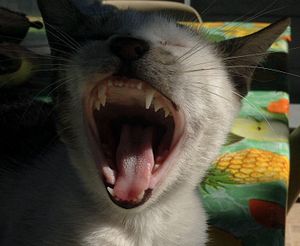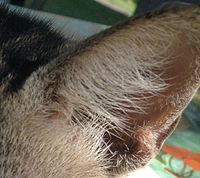Cat anatomy
|
A yawning cat, exposing its mouth
|
|
A cat's ear which has special fur for sensing and protection
|
The anatomy of the domestic cat is similar to that of other members of the genus Felis.
Cats have highly specialized teeth for the killing of prey and the tearing of meat. The premolar and first molar, together the carnassial pair are located on each side of the mouth. These teeth efficiently function to shear meat like a pair of scissors. While this is present in canids, it is highly developed in felines.
The cat's tongue has sharp spines, or papillae, useful for retaining and ripping flesh from a carcass. These papillae are small backward-facing hooks that contain keratin which also assist in their grooming.
The cat's oral structures provide for a variety of vocalizations used for communication, including meowing, purring, hissing, growling, squeaking, chirping, clicking, and grunting.
Thirty-two individual muscles in each ear allow for a manner of directional hearing; a cat can move each ear independently of the other. Because of this mobility, a cat can move its body in one direction and point its ears in another direction. Most cats have straight ears pointing upward. Unlike dogs, flap-eared breeds are extremely rare (Scottish Folds are one such exceptional mutation). When angry or frightened, a cat will lay back its ears to accompany the growling or hissing sounds it makes. Cats also turn their ears back when they are playing or to listen to a sound coming from behind them. The fold of skin forming a pouch on the lower posterior part of the ear, known as Henry's pocket, is usually prominent in a cat's ear. It is of unknown function, though it may assist in filtering sounds.
Cats are highly territorial and secreting odors plays a major role in cat communication. The nose helps cats to identify territories, other cats and mates, to locate food, and for various other causes. A cat's sense of smell is believed to be about fourteen times stronger than that of humans. The rhinarium (the leathery bit of nose we see) is quite tough to allow it to absorb rather rough treatment sometimes. The color varies according to the genotype (genetic makeup) of the cat. Cat's skin has the same color as the fur but the color of the nose leather is probably dictated by a dedicated gene. Cats with white fur have skin susceptible to damage by ultraviolet light that may cause cancer. Extra care is required when outside in hot sun.
...
Wikipedia


